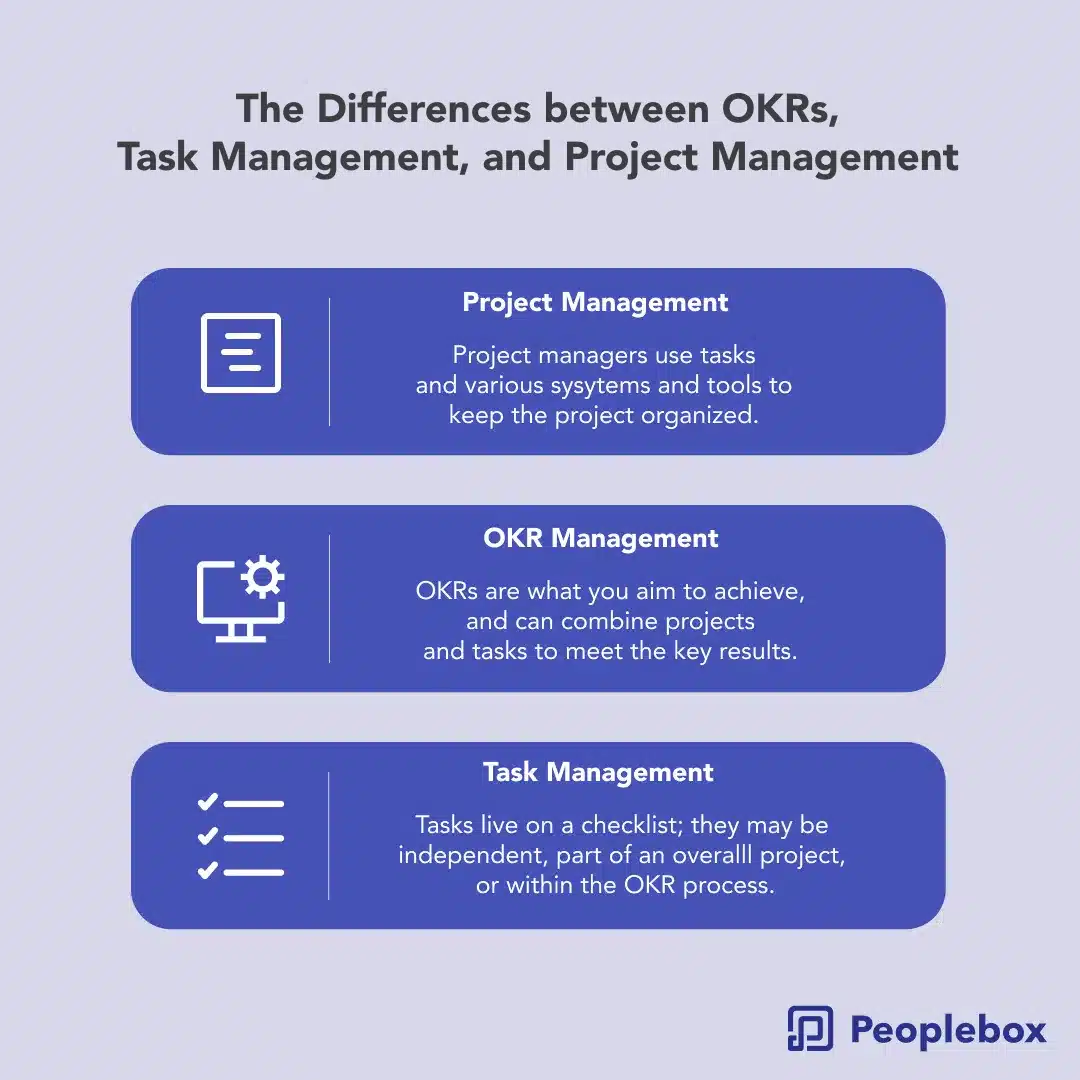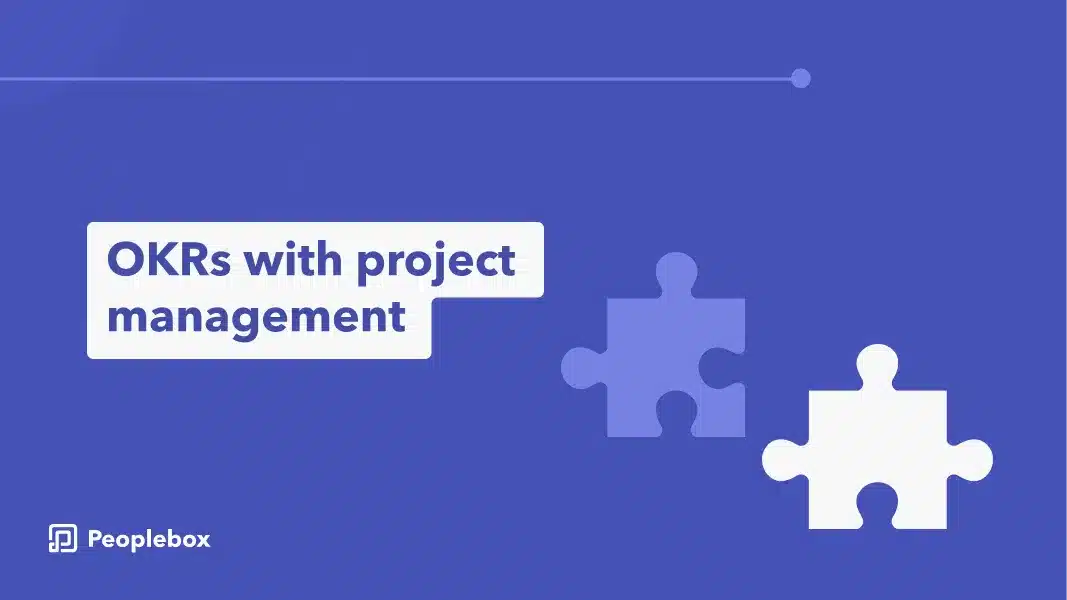Did you know that 67% of the key company functions do not align with the business strategies?
This sounds shocking, right? What’s more, this leads to a list of outcomes that include:
- Misaligned goals
- Confusion of roles and day-to-day tasks
- Missing out on important deadlines
And, the list goes on. Understand that the problem starts when you set a goal but miss sharing what to do. To avoid such chaotic results, it would be better to combine OKR and project management.
Although OKR and project management are different, they complement each other. All the projects tie together to the long-term objectives and the KRs are broken down into actionable items using project management methodologies. In this blog, we will see how these two work together and how you can integrate them into your business.
How Do OKR and Project Management Work Together?

We have understood that OKRs help measure goals and project management helps measure project tasks that lead us to achieve OKRs. Let’s now understand how they work together a little deeper.
Many companies use project management tools or to-do lists to manage their day-to-day work. What these tools do is that they break down project tasks and create roles, responsibilities, due dates, etc.
When you have diverse teams, OKRs help project managers keep their teams focused and engaged. It provides a framework for the team to ensure that the project and its work align with the objectives. It ensures focusing on the success metrics and outlining tasks for the project, especially during the project initiation phase.
Since projects deal with short-term goals and are linked to a series of tasks, OKRs become crucial to measure outcomes, driving focus on the main objectives.
On the other hand, OKR frameworks deal with strategic goals. It does not tell employees what the teams should be accomploshing on a daily basis or how to build a plan and a process to achieve those goals. Project management fills this gap by providing employees with daily tasks that they need to complete to achieve the major goal.
So, when you combine these, you get the best of both worlds– clear company objectives and tasks to achieve those objectives.
For example, a SaaS company plans to launch a new problem-solving software in the next two quarters. Traditionally, a project manager would consider the project a success if they launch the software within the decided timeline.
Now, when you combine OKR with a project, your approach will change from just completing the project on time to bringing real value to the company with the launch. Your objective could be increasing the revenue by 20% with the new software launch.
Let’s take a look at another example of OKR project management, to understand it better
Objective: Delivering projects on time 80% of the time
Key result 1: Reduce bottlenecks by 40%
KR 2: Reduce resource conflict by 30%
KR 3: Audit 10 past projects to identify common areas delaying project delivery
In this example, we assume that the time frame of 3 months (a quarter) is implied. Each KR focuses on increasing the chances of project delivery on time. OKRs here provide a precise measure of success with trackable actions to ensure that 80% of projects are delivered on time. This will contribute to the overall goal achievement of the organization. It will further improve the efficiency of the teams saving resources and time spent on a project.
How Integrating OKR With Project Management Impacts Your Business

Everyone working on their assigned responsibilities with clarity within the deadline is an ideal scenario, right? OKRs in project management make that happen.
When you combine OKR with project management, you ensure alignment between stakeholders and teams. You create an environment where everyone knows what they are responsible for and what tasks will lead them to accomplish their responsibilities. It impacts your business in a lot of other ways as well. Some of them are mentioned below:
Boosts focus
Project management tracks the output of the actions. When you combine OKR with it, you bring focus to the company vision and the desired outcomes. Instead of doing many random things, employees get to focus on strategic priorities.
Enhances motivation and productivity
With focus comes clarity and productivity. When you bring everyone on the same page, you create clarity about what needs to be done and the direction where the company wants to go. It positively impacts employee productivity because they know what they have to do and why they are doing it.
Increases employee satisfaction
OKRs in project management give direction to the entire company and help them understand how their work contributes to accomplishing the company vision. It creates a sense of satisfaction among employees that their day-to-day tasks are building up to something big. They learn the value of even mundane tasks.
Brings collaboration and transparency into the picture
These two go hand in hand when it comes to project success. OKRs create a transparent and single point of truth for everyone. It also encompasses the logic and reason behind every action. Whether it is resource allocation or budgetary decisions. Along with this, it also creates a channel of feedback and cooperation. With OKRs in project management, frequent check-ins, and suggestions become easy.
Includes holistic tracking
While project management focuses on KPIs that evaluate the activities, OKRs bring tracking practices with them focusing on the bigger picture. It gives you a more rounded view of the success that your organization is trying to achieve.
How To Set OKRs for Project Management
You now understand the importance of OKRs in project management. But we’re still missing how you need to implement them in your organization. Integrating the two strategies increases your chances of success. How you do it is by:
- Defining the objectives clearly and working on the key results.
- Once these are clear, check your projects and identify objectives linked to the projects.
- Align the objectives and the projects.
- Streamline all the activities, operations, and processes to ensure meaningful contributions by everyone
While the ways to integrate OKRs and project management are simple, there are a few things that you should pay special attention to and ensure everything falls into place.
1. Analyze your performance and success
You have your project OKR in place and are sure your team will achieve the targets. But that is not the case. You need to analyze your project OKR performance continuously. You will also have to define the criteria for success and failure. It will help you to track team performance effectively and bring changes quickly when you see any red flags. OKRs give you a clear picture of what success and failure would measure, enabling you to monitor them closely.
2. Set specific goals
OKR works on the principle of setting clear objectives. If your team is confused about what needs to be done, you will not achieve the desired outcomes. Using OKRs, you bring this clarity and set specific goals for your projects. Ensure to set inspiring objective statements to keep the teams motivated and bring creative solutions with them.
3. Create transparency
According to a study by Gartner, 67% of employees fail to understand their role when new initiatives are launched. This results in a lack of employee motivation and commitment to the job. If your employees are not aware of or understand the vision, they will not be able to give their best. Create a cohesive communication strategy, engage critical employees and start a two-way dialogue to have employees onboard and participate actively in the company objectives.
4. Foster an environment of learning from failures
In a lot of cases, companies fail to foster an environment of learning and managing failures. Managers end up blaming the team for failures and sometimes punishing them too. This affects the organization negatively. You cannot get anyone to cooperate and collaborate when they are demotivated. As a manager, you must be prepared for failure and foster an environment where everyone is encouraged to learn from their mistakes. Sit together to identify weak areas and address them respectfully by going through them objective-by-objective.
5. Challenge your teams with higher goals
OKRs encourage employees towards achieving moonshot goals. So, when you set OKRs for your project, don’t set easy goals only to ensure that you don’t face failure. Set ambitious goals and push your teams to achieve them. Assist them, offer them the resources they need, and launch initiatives to encourage them instead of fearing failure.
Conclusion
Project management and OKR have different working styles and focus areas but they both lead to the common company vision. Even when they are different, they bring out the best results, when they are combined.
Implementing both will create a complete framework to create a robust strategy, drive alignment, and boost engagement in the organization. Doing this will become easier with a tool that lets you seamlessly integrate goals into your day-to-day business tasks.
With the Peoplebox platform, you get a perfect solution for putting goals at the center of all strategic planning and activities. It makes your OKR and project management integration seamless, allowing you to track progress using visual dashboards, check-ins, reminders, and integrations with several native tools.
To check how Peoplebox integrates with your project management, book a demo today!








